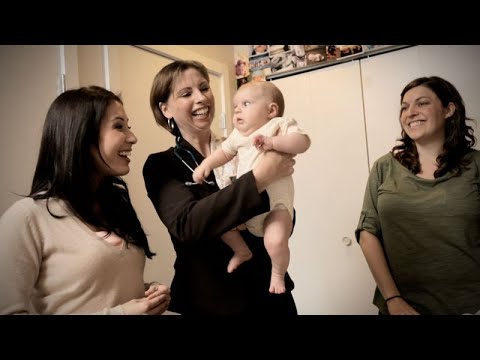Career Overview
Physician assistants, midwives and allied health professionals provide primary health care and treatment, working collaboratively with physicians and other health professionals. This group includes genetic counsellors, orthoptists and pathologists' assistants.
Physician assistants provide a range of preventative and continuous health care services to patients under the supervision of a licensed physician.
Midwives provide primary care to individuals and their newborn/infant during pregnancy, labour, birth and for up to three months postpartum.
Genetic counsellors educate and counsel patients and families who have a genetic condition to help them understand genetic information, make informed choices and work through the psychological impacts of having a genetic condition.
Orthoptists diagnose and treat binocular vision disorders. They work with an ophthalmologist.
Pathologists' assistants work under the supervision of a pathologist to examine surgical specimens, perform autopsies and assist in the diagnosis of diseases.
Job Titles
Duties
Physician assistants:
- Interview patients, do physical assessments and take medical histories
- Perform or order diagnostic tests and interpret results
- Develop and implement treatment plans and monitor patients' progress
- Give vaccinations
- Perform and assist in surgery
- Teach patients about how they can maintain their health
- May prescribe from a limited list of medications
- May participate in research
Midwives:
- Provide primary reproductive health care to individuals and their newborns/infants during normal pregnancy, labour, delivery and for up to three months postpartum
- Assess, monitor and care for patients, newborns and infants
- Prescribe hormonal contraception and diagnose and treat sexually transmitted infections
- Perform internal examinations, episiotomies and amniotomies
- Repair episiotomies and lacerations
- Perform emergency measures as needed
- Prescribe, order and administer medications
- Order, perform and interpret screening and diagnostic tests from an approved list
- Refer to and consult with other health care providers
- With specialized certification, assist in surgery, do acupuncture, oversee labour induction and pain management, including epidurals
- May do research
- May teach or mentor midwifery, nursing and medical students
Genetic counsellors:
- Provide information to families affected by or at risk of developing a genetic disorder
- Provide counselling to families affected by or at risk of developing a genetic disorder
- Help other healthcare professionals choose the most appropriate genetic test for a patient
- Help identify patients who may need further genetic assessments
- Gather and analyze medical and family history and inheritance patterns
- Run genetic risk assessments and help interpret genetic test results
- Provide information about genetic testing and related procedures to help patients make informed decisions
- Design and run genetics training programs for other healthcare professionals or the public
- May do research
Orthoptists:
- Diagnose visual system dysfunctions involving vision, eye movement, eye alignment and binocularity
- Educate patients about causes, prevention and treatment of binocular vision and other visual system dysfunctions
- In conjunction with ophthalmologists, prescribe, carry out and monitor patient treatment such as eye exercises, patching or prism therapy
- Often work as part of a medical team that includes neurologists, ophthalmologists, ophthalmic technicians and other ophthalmic medical personnel
- May educate orthoptic students, ophthalmology residents and other medical students
Pathologists' assistants:
- Examine tissues and organs to determine whether a patient has an illness and, if so, the extent of the illness
- Review relevant clinical history, laboratory data, x-rays and scans
- Work closely with pathologists to produce complete pathology reports by reviewing challenging specimens and clinical data, and taking relevant sections of tissue
- Actively participate in improving processes and diagnostic outcomes
- Communicate the need for new or updated equipment and assist with equipment evaluation and selection
- May supervise and train junior resident pathologists and morgue attendants
Earnings
Earnings is income that workers receive in exchange for their labour. Depending on the type of employment, earnings can be in the form of wages (hourly), salaries (fixed monthly or annual) or self-employed earnings.
Work Environment
# Workers Employed
280% Employed Full Time
61%Physician assistants work under the supervision of a licensed physician. The integration of physician assistants into B.C.’s health care system is ongoing. It’s anticipated that as more physician assistants become eligible for registration in B.C., they will work in clinical settings similar to other provinces. Visit the College of Physicians and Surgeons of British Columbia for the most current information.
Midwives work in private community-based clinics, hospitals and clients’ homes. They work in solo, group or interdisciplinary team practices.
Genetic counsellors work in clinics, hospitals, laboratories, education, industry, research settings and private practices. They may experience compassion fatigue from caring for patients.
Orthoptists work in private practice and hospital or university clinics.
Pathologists' assistants work for hospitals and universities.
Career Pathways
Midwives who pursue a master’s degree or doctorate in a health-related science may move into teaching or administrative positions with health authorities or government.
Genetic counsellors can move into leadership roles with experience, such as clinical manager, professional practice lead, supervisor or program director.
Orthoptists may work in subspecialty ophthalmology offices performing photography or visual field assessments and other services. To extend their practice, orthoptists may take further training in low vision rehabilitation or electrophysiology. Orthoptists can also pursue a Master of Science (MSc) in Clinical Vision Science, which may lead to careers in the health, education, medical, research, pharmaceutical and public sectors.
Pathologists’ Assistants may advance to senior pathology assistant and help teach future health care professionals.
There is no mobility between these occupations without further training.
Occupational Interests
It’s important to understand what kinds of occupations align with your interests.
For more about occupational interests visit Skills for the Future Workforce > Characteristics.
Here are the top occupational interest(s) for this career profile:
Education, Training and Skills
Physician assistants
- Must complete a university degree in an accredited physician assistant program
- Must be certified with the College of Physicians and Surgeons of British Columbia
- Must be certified either by the Physician Assistant Certification Council of Canada (PACCC) or by the (U.S.) National Commission on Certification of Physician Assistants (NCCPA)
To write the PACCC certification examination, applicants must be a member of the Canadian Association of Physician Assistants (CAPA). Continuing education is required to maintain a physician assistant license.
Learn more about physician assistant programs in Canada and physician assistants in B.C.
Midwives
- Must complete an undergraduate university degree program in midwifery or its equivalent and a period of mentored practice
- Must successfully complete a national examination administered by the Canadian Midwifery Regulators Council before registration
- Must register with the British Columbia College of Nurses & Midwives (BCCNM)
- Must be members of the Midwives Association of British Columbia, through which they receive their liability insurance
- If internationally educated, must complete an orientation to practice and a period of mentored practice
The University of British Columbia (UBC) offers the only midwifery education program in B.C.
Genetic Counsellors
- Must complete a master’s degree in genetic counselling (or equivalent)
- May need board certification through the Canadian Board of Genetic Counsellors (CBGC) or the ABGC (American Board of Genetic Counseling)
- If board certification is required, they must maintain their credentials through ongoing continuing education
Orthoptists
- Must earn a bachelor's degree followed by a two-year accredited education program
- Must successfully complete national examinations and become certified with the Canadian Orthoptic Council (COC)
- Must maintain COC certification through continuing education
- May seek membership with The Canadian Orthoptic Society (TCOS) to access continuing education opportunities
Dalhousie University offers the only orthoptics program in Canada.
Pathologists' assistants
- Usually need a master’s degree in a pathologists’ assistant program
- Usually require certification by the Canadian Certification Council of Pathologists’ Assistants (CCCPA), the American Society for Clinical Pathology – Board of Certification (ASCP BOC) or Pathologists’ Assistant Certification Examination
- May need membership in the Canadian Association of Pathologists (CAP-ACP) (some employers)
Midwives who are certified for an occupation by a regulator elsewhere in Canada can apply for the same certification from the regulator in B.C. Under the terms of the Canadian Free Trade Agreement (CFTA), most applicants who are transferring their credentials from elsewhere in Canada will not be required to complete additional training or testing. However, the B.C. regulator may ask applicants to provide further information, such as a letter of good standing, references or a criminal record check.
For information about labour mobility in Canada, visit www.workersmobility.ca.
Those who trained outside of Canada and never received certification from any Canadian jurisdiction must complete an approved midwifery bridging program, including additional training, examination and a period of supervised practice.
Contact the British Columbia College of Nurses and Midwives (BCCNM) for details on how to apply for certification in B.C.
View a list of Professional Regulatory Authorities in B.C.
Education programs in B.C.

Top Skills
Every job calls for a certain set of skills. Knowing those skills is the first step in finding a good career fit.
Here, you will find the 10 most relevant workplace skills. Some are more important to achieving success in a certain career than others. These skills may come naturally to you or you may need to gain them through education, training and experience.
See the list of work-related skills below, ranked in order of importance for this career. Check out the list and see if this career matches your skills—take that first step!
Giving full attention to what other people are saying, taking time to understand the points being made, asking questions as appropriate, and not interrupting at inappropriate times.
Talking to others to share information effectively.
Understanding written sentences and paragraphs in work-related documents.
Being aware of others’ reactions and understanding why they react as they do.
Using logic and reasoning to identify the strengths and weaknesses of alternative solutions, conclusions or approaches to problems.
Communicating effectively in writing as appropriate for the needs of the audience.
Actively looking for ways to help people.
Considering the relative costs and benefits of potential actions to choose the most appropriate one.
Keeping track of and assessing your performance, other individuals, or organizations to make improvements or take corrective action.
Understanding how new information could be used to solve current and future problems in making decisions.
Labour Market Statistics
Discover data, facts and information that have been gathered and analyzed. Learn about the characteristics of the economy and labour market in B.C.
Employment
Find out about employment types and trends by region and industry.
Employment
280Employment by Region







| Region | Employment | % Employment of this Occupation |
|---|---|---|
| Cariboo | 0 | 0.0% |
| Kootenay | 0 | 0.0% |
| Mainland/Southwest | 170 | 60.7% |
| North Coast and Nechako | 0 | 0.0% |
| Northeast | 0 | 0.0% |
| Thompson-Okanagan | 20 | 7.1% |
| Vancouver Island/Coast | 70 | 25.0% |
Labour Market Outlook
The B.C. Labour Market Outlook is a 10-year forecast of the expected supply and demand for labour in the province. It’s usually updated every year. The purpose is to provide British Columbians with the knowledge to make informed decisions on careers, skills training, education and hiring.
Forecasted Job Openings (2025-2035)
160Forecasted Job Openings
Forecasted Employment Growth Rate
Composition of Job Openings
Job Openings by Region (2025-2035)







| Region | Job Openings | Avg. Annual Employment Growth |
|---|---|---|
| Cariboo | Not available | Not available |
| Kootenay | Not available | Not available |
| Mainland/Southwest | 110 | 2.1% |
| North Coast and Nechako | Not available | Not available |
| Northeast | Not available | Not available |
| Thompson-Okanagan | 10 | 2.2% |
| Vancouver Island/Coast | 40 | 2.0% |
Industry Highlights
Learn about the opportunities in B.C.'s major industries, including employment trends, earning potential, locations of work and more.
Forecasted Job Openings by Industry
| Industry | Job Openings (2025-2035) |
|---|---|
| Health Care and Social Assistance | 150 |
| Educational Services | 10 |
Insights from Industry
Physician assistants
Demand for physician assistants is growing. Governments are investing in physician assistants, and they can practice in all provinces. Physician assistant education is also expanding, with new programs emerging across Canada.
Midwives
With B.C.’s ongoing shortage of maternity care providers, midwives are in high demand, particularly in rural and remote areas of B.C. They provide client-centred, culturally competent and sensitive care to the needs of diverse communities, including Indigenous families. Challenges include irregular and sometimes long work hours, including overnight, weekends and holidays. The work can be physically demanding (helping to move and turn patients, bending and kneeling during labour support and driving between work sites).
Genetic counsellors
About three-quarters of genetic counsellors in Canada work in direct patient care. They also work in research, education, laboratories and industry/biotechnology roles. Use of genetic testing in patient care continues to grow, and with it the potential for more demand for genetic counsellors. Clinical jobs in genetic counselling are competitive and usually filled quickly.
Orthoptists
Shortages of orthoptists are expected to increase as professionals continue to retire.
Pathologists’ assistants
Growth in the number and range of diagnostic tests has led to an increased demand for pathologists’ assistants.
Resources
-
American Board of Genetic Counselingwww.abgc.net/
-
BCHealthCareers.cabchealthcareers.ca/
-
British Columbia College of Nurses and Midwives (BCCNM)www.bccnm.ca/Pages/Default.aspx
-
Canadian Association of Genetic Counsellorswww.cagc-accg.ca/
-
Canadian Association of Midwives (CAM)canadianmidwives.org
-
Canadian Association of Midwives – Job Opportunitiescanadianmidwives.org/job-listings
-
Canadian Association of Pathologists – Pathologists Assistantscap-acp.org/page/cccpa-certified
-
Canadian Association of Physician Assistants (CAPA)capa-acam.ca
-
Canadian Board of Genetic Counselling (CBGC)www.cbgc-cccg.ca/
-
Canadian Midwifery Regulators Councilcmrc-ccosf.ca/
-
Canadian Orthoptic Council (COC)orthopticscanada.org/
-
The Canadian Orthoptic Society (TCOS)tcos.ca/
-
Canadian PA (Physician Assistants)canadianpa.ca/
-
Canadian Pathologists’ Assistantscanadianpatha.ca/
-
College of Physicians and Surgeons of British Columbia – Physician Assistantwww.cpsbc.ca/registrants/current-registrants/registration-and-licensing/physician-assistant
-
Fraser Health – Careerscareers.fraserhealth.ca
-
Interior Health – Jobsjobs.interiorhealth.ca/
-
Island Health – Careerswww.islandhealth.ca/careers
-
Midwives Association of British Columbia (MABC)www.bcmidwives.com
-
Midwives Regulation (Government of British Columbia)www.bclaws.gov.bc.ca/civix/document/id/complete/statreg/281_2008
-
National Society of Genetic Counselors – About Genetic Counsellingwww.nsgc.org/About/Becoming-a-Genetic-Counselor
-
Northern Health – Careerscareers.northernhealth.ca/
-
Physician Assistant Certification Council of Canadacapa-acam.ca/paccc/
-
Physician Assistants for Research, Scholarship and Education in Canada (PARSEC)www.parsec.live/#:~:text=Physician%20Assistants%20for%20Research%2C%20Scholarship,research%2C%20scholarship%2C%20and%20education
-
Provincial Health Services Authoritywww.phsa.ca/
-
University of British Columbia (UBC) Midwifery Programmidwifery.ubc.ca/
-
Vancouver Coastal Health – Careerscareers.vch.ca








